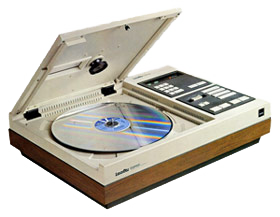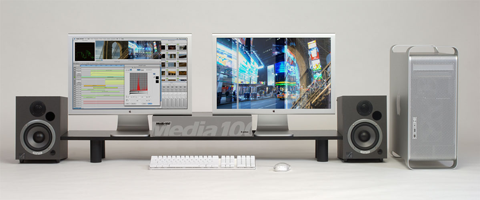Company HistoryThe Beginning
The Age of Computer Animation BeginsAtari was a DiaQuest client in those days. Atari's Michael Mackay and Sherman Kennedy wanted a computer-based VTR controller but recoiled at the price of the sole product available, the Lyon Lamb system at $13,000. Bill Claghorn, having just returned from a Sony professional broadcast automation seminar discussing SMPTE RS-422 communication and tributaries, felt that this could be done much less expensively with a card for the newly-introduced IBM PC. DiaQuest developed and marketed the first Sony and Ampex RS-422 controller as a board and software for the IBM PC. The board included an NTSC RS-422-A sync generator, an odd/even field sync detector, and GPIO interface. This forward looking engineering turned out to be a great idea as future decks took advantage all of these features. The odd/even sync detector was needed for the Ampex VPR-3, VPR-6, and VPR-80. The RS-170-A standard was important as the chroma sub-carrier needed to be phase locked to the horizontal sync.
VTR control was expanded to Parallel VTR recorders including Sony and Panasonic with a Parallel board. Larry Abel came on board to make a PAL sync generator. DiaQuest produced an early NuBus board for the Mac as well. Larry Abel became the lead engineer for the Mac, in what was to become a long relationship as a Mac software engineer. DiaQuest Enables a New IndustryAt the same time, Silicon Graphics did not have a real recordable video output board yet. DiaQuest proposed a stand-alone product containing a rack mount PC and Truevision Targa board. DiaQuest worked closely with SGI and WaveFront (a leading 3D graphics company along with competitors Alias and SoftImage) to market rendering output devices to VTR. DiaQuest provided a crucial element for SGI by developing frame-accurate products for real-time capture and layoff, both standard def and HD. DiaQuest worked closely with the SGI engineering team to develop the tight timing standards needed to guarantee absolute frame accuracy. Outputting frames to tape was still a very slow process. Larry Abel came up with the idea of Quick-Pass. The idea was to eliminate the need for pre-roll for each single frame recorded. Instead we would record a frame, load in the next frame in sequence depending on load time and then record that frame while the VTR was still running. If it took the time of three frames to load an image, we would record every fifth frame in the sequence of frames. That way only five passes were needed for the entire sequence instead of one pass with preroll for each frame. DiaQuest Brings the Age of PC and Mac to Broadcast GraphicsDiaQuest developed many plug-ins to facilitate the transfer of frames between Macs and PCs and Adobe products such as Photoshop, AfterEffects and Premiere. The result was that DiaQuest expanded and developed control products for Digital Disk Recorders, both direct SCSI and Ethernet. Larry Abel led the development the Macintosh products and Bill's team developed the PC products. This lead to DiaQuest becoming among the first few Apple Quicktime developers. Today the DiaQuest team has an unequalled knowledge of Quicktime and its tools. DiaQuest worked closely with engineering from Accom, Ampex, Sierra Design Labs, DoReMi, Abekas and other DDR manufacturers.
DiaQuest teamed up with many third parties for bundled products. For example, DiaQuest developed complex plug-ins for Autodesk 3D-Studio MAX. DiaQuest TodayIn 1999, DiaQuest was acquired by WaveFrame, and the team ported the WaveFrame Digital Audio Editing System from proprietary hardware to new-generation PC software and hardware platforms. During this time, the DiaQuest staff developed extensive knowledge in file based workflows and developed tools for working with OMF, MXF and AAF files. In 2001, Advanced Systems Group, LLC acquired DiaQuest’s intellectual property and formed DiaQuest Products, LLC. In 2009, DiaQuest launched two helper applications for Apple’s Final Cut Server: At 2012 NAB, DiaQuest introduced a new product, ProductionLink for Adobe, the Adobe CS suite plug-in for Avid Interplay access. ProductionLink for SCRATCH, the plug-in to allow ASSIMILATE SCRATCH and Avid Interplay to work together, followed at the 2012 IAB show. In just a few short weeks after the 2012 NAB show, ProductionLink is being integrated into some of the largest broadcast production facilities in the world. DiaQuest also provides custom software engineering services for companies in the Film and Video space including:
|

 In 1982, Sony came out with the SMC-70 computer,
In 1982, Sony came out with the SMC-70 computer,  Howard Gutstadt, DiaQuest's first VP of Marketing had a relationship with Cubicomp. They thought they had a CAD product but Howard convinced them to go into video. DiaQuest co-marketed with Cubicomp for some time with the DiaQuest frame-by-frame-editing VTR control product.
Howard Gutstadt, DiaQuest's first VP of Marketing had a relationship with Cubicomp. They thought they had a CAD product but Howard convinced them to go into video. DiaQuest co-marketed with Cubicomp for some time with the DiaQuest frame-by-frame-editing VTR control product.  The Mac board was actually a PC on a NuBus card. A parallel control board was also developed for the Mac. DiaQuest even developed a
The Mac board was actually a PC on a NuBus card. A parallel control board was also developed for the Mac. DiaQuest even developed a  DiaQuest even provided frame-accurate bundled VTR control for the SGI release of Premiere. DiaQuest designed for ViewGraphics (now Optibase) the first real-time sustained HD playback of uncompressed video on the PC and frame-accurate capture and layoff. DiaQuest also provided bundled VTR control for Media 100 (right), a relationship that continues today.
DiaQuest even provided frame-accurate bundled VTR control for the SGI release of Premiere. DiaQuest designed for ViewGraphics (now Optibase) the first real-time sustained HD playback of uncompressed video on the PC and frame-accurate capture and layoff. DiaQuest also provided bundled VTR control for Media 100 (right), a relationship that continues today.